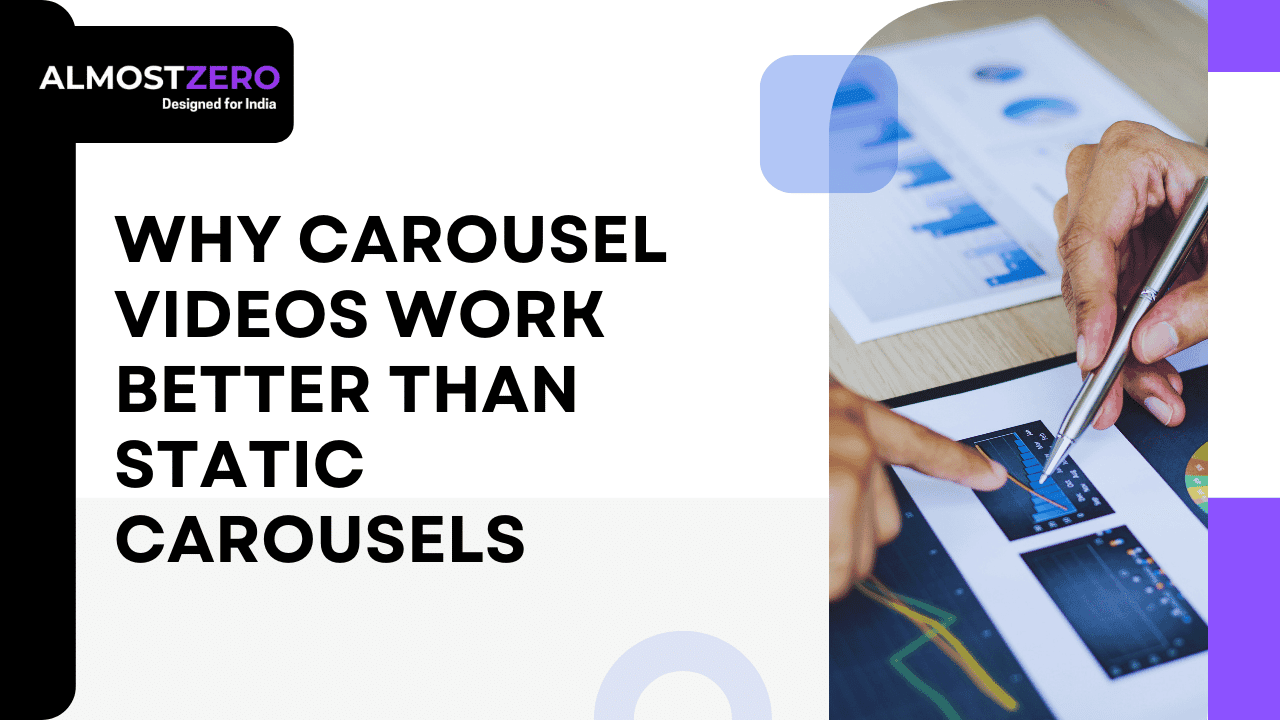Why Carousel Videos Work Better Than Static Carousels

Scroll through Instagram or Facebook, and you’ll often see two familiar formats—static carousels (multiple images you swipe through) and carousel videos (where each frame contains motion, animation, or short clips).
Both formats are powerful, but in 2025, carousel videos are proving to be more effective than static carousels. Why? Because audiences are craving dynamic, story-driven, and engaging content. Static carousels still have their place, but video-based carousels grab attention faster, keep people engaged longer, and ultimately drive higher conversions.
In this blog, we’ll break down why carousel videos outperform static carousels, the psychology behind motion, examples of successful campaigns, and best practices to maximize results.
The Difference: Static vs Video Carousels
- Static Carousels: Multiple images placed side by side. Good for product catalogs, step-by-step guides, or promotions.
- Video Carousels: Each card includes video clips, animations, or transitions. Ideal for storytelling, showcasing product use, and building immersive experiences.
While static carousels rely on visuals + text, video carousels combine visuals, audio, and motion—which creates stronger emotional and cognitive impact.
Why Carousel Videos Work Better
1. Motion Captures Attention Instantly
The human brain is wired to notice movement. A video card in a carousel draws more attention than a still image, helping ads stand out in busy feeds.
2. Stronger Storytelling Power
Video carousels let you tell a mini-story across multiple slides:
- Slide 1: Problem
- Slide 2: Struggle
- Slide 3: Solution (your product in action)
- Slide 4: Results/testimonials
- This sequential narrative feels natural and keeps users swiping.
3. Show, Don’t Just Tell
Instead of showing a static product image, carousel videos can:
- Demonstrate features in action
- Highlight before-and-after transformations
- Include customer reactions
This builds trust because people see the product in real life.
4. Higher Engagement Rates
Meta’s internal studies and industry benchmarks show that video ads generate more comments, shares, and clicks than static formats. Carousel videos combine the best of both worlds: interactivity (swiping) + motion (videos).
5. Improved Ad Recall
Static carousels rely on text and images, but video carousels create multi-sensory experiences (sound, visuals, motion). This makes the ad more memorable and increases brand recall.
6. Better for Explaining Complex Products
If your product needs education, a static image may not be enough. Video carousels let you explain each step in short clips, making complex products feel simple.
7. Increased Conversion Rates
The combination of higher attention + better storytelling + emotional pull leads to stronger conversions. When users understand and connect with a product, they’re more likely to act.
Examples of Carousel Videos in Action
1. E-commerce (Fashion)
Instead of static outfit pictures, carousel videos can show:
- Model walking in the outfit
- Styling tips across cards
- Quick transitions showing color/size variety
This helps customers visualize how the product looks in real life.
2. Fitness Apps
A static carousel might show “5 features of the app.”
A video carousel, on the other hand, could show:
- A trainer guiding workouts
- Screens of progress tracking
- Success stories with before/after clips
This builds trust and excitement.
3. Food Delivery Brands
Instead of showing static food images, brands like Zomato/Swiggy could use video carousels with:
- Sizzling food close-ups
- Delivery speed animations
- Happy customer reactions
It makes the ad more mouth-watering and engaging.
4. B2B SaaS Tools
Static images of dashboards look boring. A video carousel can show:
- Each feature in action
- Problem → solution sequence
- Animated charts that feel alive
Psychological Triggers Behind Carousel Videos
- Attention Economics: Motion breaks through crowded feeds.
- FOMO Effect: Seeing results in action (like fitness transformations) triggers urgency.
- Empathy: Human faces + emotions in video create stronger relatability.
- Sequential Curiosity: Users swipe to “see what’s next” in the story.
Best Practices for Carousel Video Ads
1. Start Strong in the First 3 Seconds
Your first card should grab attention with bold motion, text overlays, or a powerful question.
2. Keep Videos Short & Snackable
Each card should be 5–10 seconds max. Long videos reduce swipes.
3. Design a Story Flow
Treat the carousel as chapters of a story, not random clips.
4. Add Text Overlays
Many users watch without sound. Add captions or keywords on screen.
5. Optimize for Mobile
Vertical videos with clear visuals and large text perform best.
6. Test Static vs Video Mix
For some industries, a mix works: first card static (bold claim), following cards video (demonstration).
7. Use Strong CTAs
Each video card should include prompts like “Swipe →” or “See More.” The final card should have a bold CTA: “Shop Now” or “Start Free Trial.”
When Static Carousels Still Work
Static carousels aren’t dead—they’re still useful when:
- The goal is showing multiple products quickly.
- The audience prefers simplicity.
- You’re targeting regions with low internet speed.
However, when you want high engagement and storytelling, carousel videos are the superior choice.
Mistakes to Avoid
- Overloading with too much text in videos.
- Using random clips without a clear narrative.
- Forgetting subtitles (most users watch muted).
- Making videos too long (kills swipe momentum).
Future of Carousel Video Ads in 2025
The future is leaning toward interactive carousel videos:
- Users will be able to tap within videos to explore features.
- AI will auto-generate video carousels from product catalogs.
- Personalization will serve different video sequences based on user behavior.
This means carousel video ads will only get smarter, more dynamic, and more effective in driving conversions.
Conclusion
Static carousels are reliable, but carousel videos take engagement to the next level. By combining interactivity, storytelling, and motion, they create ads that are harder to ignore and easier to remember.